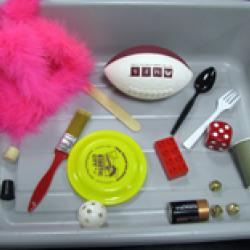Source Institutions
Source Institutions
Add to list Go to activity
Activity link broken? See if it's at the internet archive

This activity was designed for blind learners, but all types of learners can use it to learn to differentiate between qualitative and quantitative observations and to practice data collection. In this activity, the learner works with a partner and describes and records the items in their mystery box. Low vision learners can practice using their vision to collect data by putting their objects in an open tub, while sighted learners can be encouraged to use their tactile senses by putting their objects in a closed box with access only for their hands to enter.
- 10 to 30 minutes
- 10 to 30 minutes
- $5 - $10 per group of students
- Ages 11 - 18
- Activity
- English
Quick Guide
Materials List (per group of students)
- Variety of items with varying sizes and textures, including a couple that make sounds
- Boxes or dish pans
- Talking scale
- Talking or tactile tape measures or rulers
- Equipment to record data, for example, electronic note takers, or Braillers, pens, and paper
Subjects
-
Life Sciences
-
Human Senses and Perception
- Touch
-
Human Senses and Perception
-
Mathematics
-
Data Analysis and Probability
- Data Analysis
- Data Collection
-
Data Analysis and Probability
-
The Nature of Science
-
The Scientific Process
- About Inquiry
- Gathering Data
- Communicating Results
-
The Scientific Process
Audience
To use this activity, learners need to:
- touch
Learning styles supported:
- Involves teamwork and communication skills
- Involves hands-on or lab activities
Other
Components that are part of this resource:
Access Rights:
- Free access
By:
Rights:
- All rights reserved, Perkins School for the Blind,
